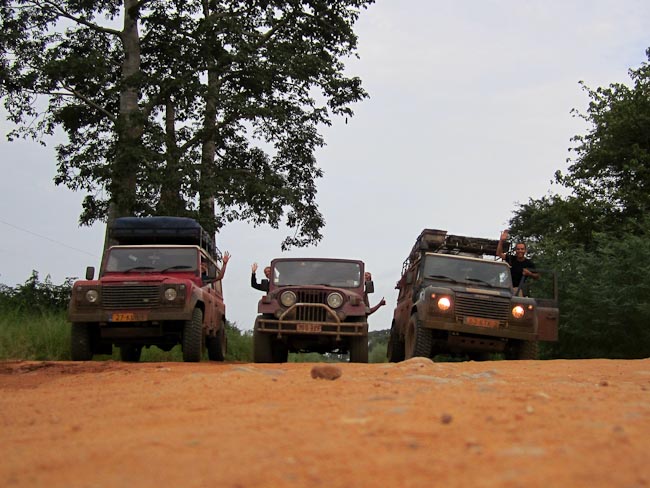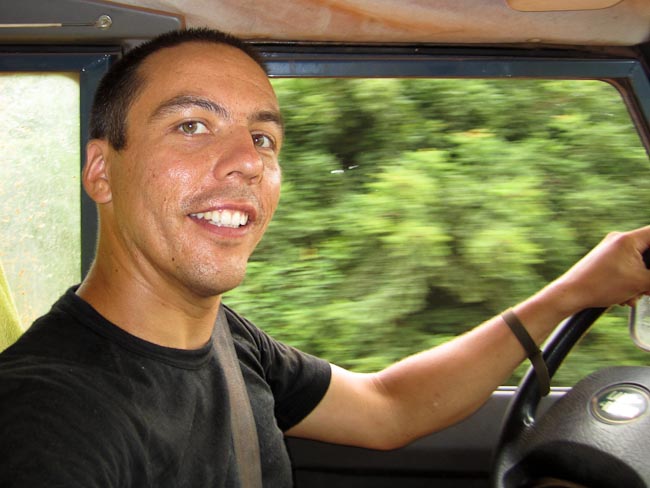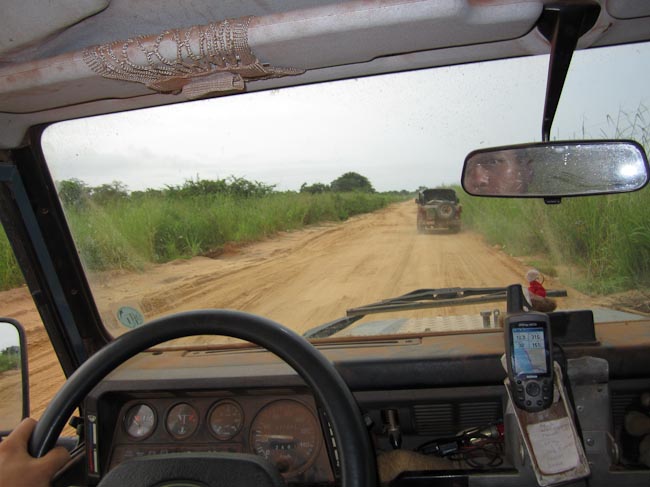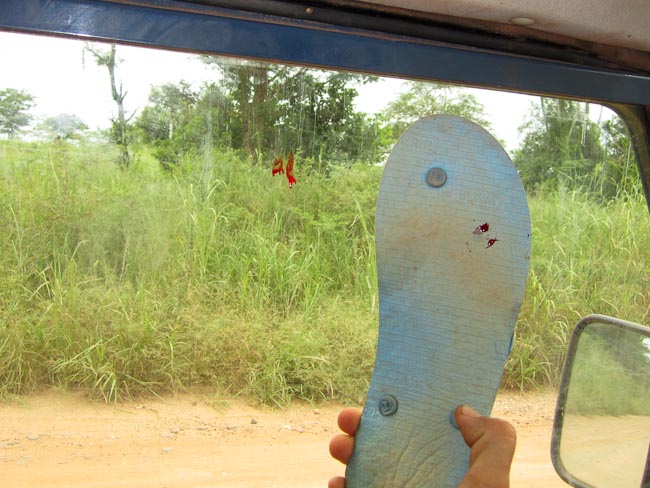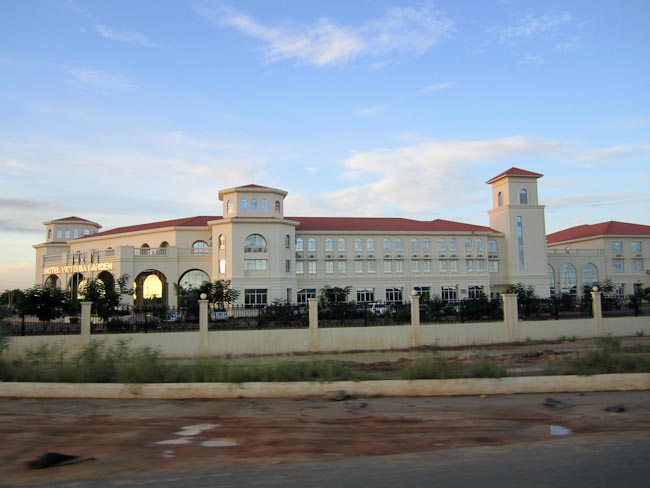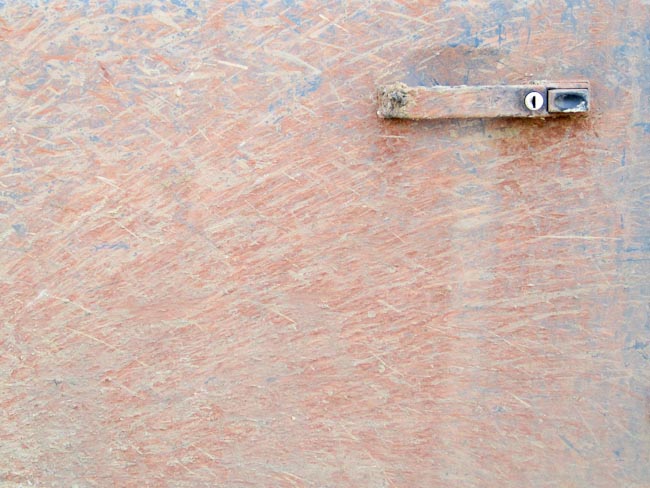Angola - First 3 days
Day 163 (17 March) – Angola day 1: Matadi-N’zeto
We leave Matadi early and drive past the truck carnage from the night. It is an easy crossing out of DRC at Songololo into Angola. But once in Angola, none of us speaks Portugese and it is a bit of a communication shock as no one in Angola speaks anything but Portugese!
We meet up again with Ruben and Renee at the border and will travel with them through Angola. Sebastian and Birte have left yesterday for Angola and are one day ahead.
We are not sure what to expect in Angola. All we really know about is the long civil war and that it is nearly impossible to get anything but a 5 day transit visa. Five days to cross 2300 Kilometers!
The first stretch from the border to Mbanza Congo is beautiful blue light and lush green grassland with dark green patches of tropical forest. We come to one police roadblock. They are most interested in our Angola guidebook and really want to keep it – sorry guys! We still need it!! We fuel up in Mbanza Congo and have a good tar road to N’zeto where we spend out first night in the backyard of the local (Polish) priest, Father Emilio.
Day 164 (18 March) – Angola day 2: N’zeto-Kwanza (via Luanda)
We are told that the road from N’zeto to Luanda has a bad stretch of about 200kms. We leave N’zeto on a dirt track. And the road is slowish going but we’ve definitely seen worse. The biggest problem is the tse-tse flies. They are everywhere and the bite of a tse-tse is so painful! They really take a chunk out of you and the bite swells to a huge red, itchy welt. We are driving as fast as possible so we can keep the windows open for cooler air but keep out the tst-tse flies. Then… Ruben and Renee’s suspension completely breaks…
R&R’s upper spring leave breaks, meaning they lost their suspension completely on one side. They need to offload as much weight as possible and pack everything into Niels’ car. Stanley drives with Niels and Renee with Julia and the kids. Unfortunately, this also means driving 15-20km/hr. We immediately roll up the windows but it is too late –there are already plenty of tse-tse flies in the car. We are madly trying to kill them – but you must really smash them three times in order to kill them, slippers work best – it is as if they have a coat of armor!
Fortunately, at this point, we are only driving 20 because we are so busy trying to kill the flies; it would be reckless to go any faster. We are getting bitten plenty as well. Even poor Senna. Usually bites don’t bother her but she is trying to scratch, she even found a toothbrush and is trying to use that to scratch!
There are a few police stops and for all we know they are asking for a bribe but since we speak no Portugese we have no idea. After several minutes of us reciting phrases from the back of the guidebook we get waved on with a smile.
Only once, Niels was passing this super slow tuc-tuc apparently on a bridge before the police stop. Got pulled over for the papers and the officer wanted to write a ticket. Luckily that Renee speaks fluent French and bits of Spanish, so she could understand Niels was about to get a ticket… Niels just being stubborn, there is no such rule that you are not aloud to pass any vehicle on a bridge and no, it is definitely not a international common rule, like the officer was saying. Niels had a laugh, checked out the signs before the bridge, took back his papers and drove off.
Finally we make it to Luanda. The infrastructure is AMAZING. It looks like Spain or Florida. They are re-building at a furious pace – great roads, buildings, restaurants, hotels, there are fancy cars, apartment blocks and houses. There are oil and diamonds in Angola but we never imagined that a country could get back on its feet so fast after such a long and destructive civil war. It is really, really impressive. There are Chinese everywhere and they seem to be rebuilding Angola. Luanda is MASSIVE and we are advised not to under estimate the traffic. We arrive on the outskirts on Friday afternoon and even 40km out of town the traffic is bad. We have a GPS point for a camping place south of Luanda and we take the new ring road around the city and drive on.
It is dark by the time we come near to the turn off for the camping spot. There is a bridge with a police control post and we realized that our backlights are not working. Ofcourse, luck is not on our side and we get pulled over. The officer asked for driving license and other car papers and walks around the car. We pushed the brakes (which is the same light as the rear lights) while he walks around to check the car. Luckily he didn’t notice and lets us go. While accelerating we hear a whistle in the back, but we ignore it and moved on. Unfortunately,(for us) there has been a lot of rain in Angola recently. In the dark we are turning off of a single lane highway so don’t have time to properly assess the turn off. Immediately we slide into the mud. We drive a bit forward to allow the others off the road and are really slipping. We see a recent track and put the Red Landy in low gear and difflock and push on but it is difficult for us and Ruben and Renee will never make it. Niels pulled R&R behind a bush and we leave their car. They jump in with Niels.
We can take a moment to review the list of stupid mistakes we managed to accomplish in just 10 minutes:
1. We are driving off road in the dark
2. In a military zone
3. In a flood plane
4. In Angola – the most heavily land mined country in Africa
And somehow, knowing all of that we managed to get even stupider! We know you always walk a difficult patch before you drive it. We walked it all the time – we had just been walking for days in Congo and DRC. But somehow (also as it was well into darkness) we didn’t feel the need to do it and we just drove – into the deep, deep, sticky mud. We continue on for maybe 500 meters and then we are hopelessly stuck in the mud. The mud has the consistency of nearly dry cement. It is wet enough to sink into (on foot or in the car) but when you separate it from the blob (on your boot or tire) it immediately begins to harden.
After much digging and pushing we were able to be pulled out by Niels. We pitched the tents at about 21:30 on the highest patch of ground around and prayed it wouldn’t rain. Then we fell into bed.
Note: The Angola guidebook advises ‘no offroad driving in the rainy season’. Usually this means be wary roads/trails that can be used instead of the main roads. In Angola ‘off road’ means 1 meter off the road as we experience in Kwanza and then later on on the way to Benguela.
Day 165 (19 March) – Angola day 3
Early morning, we packed up quickly seeing the storm clouds on the horizon. Any drops of rain and we might not make it out of there!
The drive south of Kwanza toward Benguela is beautiful savannah filled with baobab trees. As we drive we catch glimpses of the Atlantic Ocean. There is a long stretch where there are no villages and a great tar road. Near Sumba we round the corner to find a newly jack-knifed semi truck. 300 meters later we find what must be last week’s wreck. And just beyond that what was probably the week before. A RAV4 passes us with a shattered windscreen. Good roads are not always such an advantage…
We arrive in Benguela in late afternoon. It is a beautiful old city. In about 1617, the first settlers from Portugal arrived. The bay looked ideal; fish were abundant, fertile soils and plentiful fresh water. And so Manuel Cerveira Pereira founded the settlement of São Filipe de Benguela, with the intention of exporting the silver and copper. However, Benguela was the worst place ever. Poor Manuel had chosen a place that was thrived by mosquitos and within a year all but ten men died.Silver remained elusive and copper was of poor quality.
This was changed around in the early 20th century when they drained all the swamps and got rid of the mosquitos. Nowadays, Benguela is a balmy and tropical city with a relax feel. It is one of Angola’s most picturesque cities with deep blue ocean and long sandy beach (which we didn’t see), greem palm trees and colonial buildings set around open squares. Not the city you would expect in this part of Africa. The area were we stayed even reminded Niels of Portugal.
There are so many beautiful places and sights it is painful to have to drive through so fast. We would definitely return to Angola for holiday (providing we can get a visa!!)


